大气湍流中的激光传输课件
- 格式:ppt
- 大小:4.42 MB
- 文档页数:17
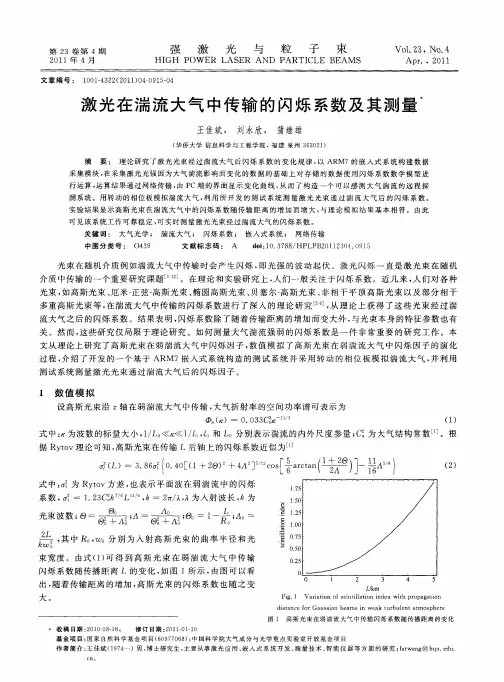
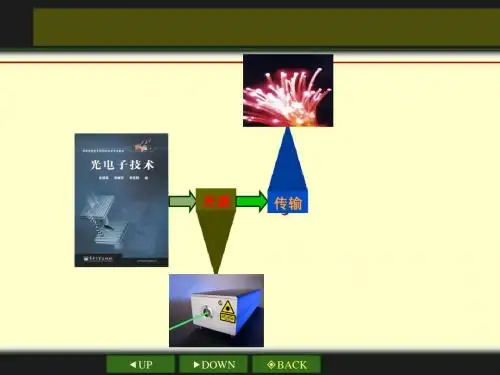
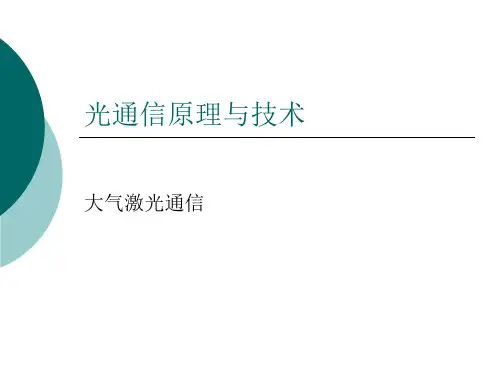
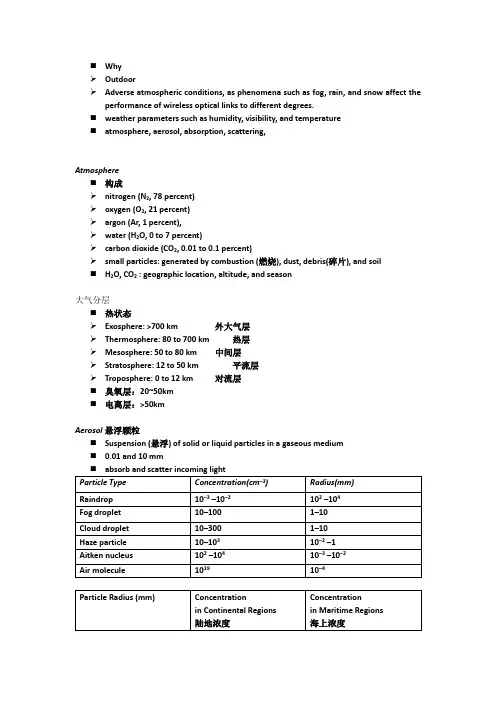
⏹WhyOutdoorAdverse atmospheric conditions, as phenomena such as fog, rain, and snow affect the performance of wireless optical links to different degrees.⏹weather parameters such as humidity, visibility, and temperature⏹atmosphere, aerosol, absorption, scattering,Atmosphere⏹构成nitrogen (N2, 78 percent)oxygen (O2, 21 percent)argon (Ar, 1 percent),water (H2O, 0 to 7 percent)carbon dioxide (CO2, 0.01 to 0.1 percent)small particles: generated by combustion (燃烧), dust, debris(碎片), and soil⏹H2O, CO2 : geographic location, altitude, and season大气分层⏹热状态Exosphere: >700 km 外大气层Thermosphere: 80 to 700 km 热层Mesosphere: 50 to 80 km 中间层Stratosphere: 12 to 50 km 平流层Troposphere: 0 to 12 km 对流层⏹臭氧层:20~50km⏹电离层:>50kmAerosol悬浮颗粒⏹Suspension (悬浮) of solid or liquid particles in a gaseous medium⏹0.01 and 10 mmAttenuation⏹absorbed and/or scattered⏹For the typical wavelengths employed by wireless IR links (850 nm, 1550 nm), theattenuation contribution from the atmosphere is relatively low compared to the attenuation contribution from weather conditions.clear atmospheric conditions: 0.2 dB/kmurban regions (due to dust) : 10 dB/kmheavy fog: >300 dB/kmAbsorption⏹conversion of the energy of a photon to internal energy⏹Absorption peak⏹The atmospheric absorption is wavelength dependent 吸收和波长有关⏹Neither nitrogen nor oxygen, which are two of the most abundant, contribute toabsorption in the infrared part of the spectrum.Scattering⏹Dispersal into a range of directions⏹physical interactions(物理作用)⏹The scattered light is polarized, and of the same wavelength as the incidentwavelength, which means that there is no loss of energy to the particle.偏振/波长一致⏹The behavior of the re-radiation (scattering) depends on the characteristics of theparticle: its size in relation to the wavelength of the intercepted energy, its index of refraction, and its isotropy(各向同性)types of scattering⏹Rayleigh, Mie, and nonselectiveRayleigh: particles size ~ wavelength of the light gases (mainly), also occur in transparent solids and liquids.Mie: particles with diameters larger than one tenth of the incident light wavelength up to a diameter equal to the wavelength of the incident lightnon-selective: particles size is larger than the incident wavelength.粒子大小影响到散射能量分布⏹The size of the particle, defines the type of symmetry of the scattered energy withregard to the direction of propagation of the incident energy.⏹If the size of the particle is equal to the wavelength of the incident light, thescattering by the particle presents a large forward lobe and small side lobes that start to appear.⏹As the size of the particle becomes smaller, the backward lobe becomes larger and theside lobes disappear.⏹When the size of the particle is 10 percent the size of the wavelength of the incidentbeam, the backward lobe is symmetrical with the forward lobe.⏹In the context of wireless IR communications, Rayleigh and Mie are probably the mostrelevant types of scattering, as they refer to the scattering of light from molecules of air, and to the scattering of light from other atmospheric particles such as fog, mist, and haze⏹Oxygen and nitrogen contribute to Rayleigh scattering.Mie scattering⏹The attenuation due to Mie scattering can reach values of hundreds of dB/km⏹highest contribution arising from fog 300 dB/km⏹disrupt a communication link even for distances of less than 100 meters⏹wavelength dependenttotal extinction coefficient⏹Total extinction coefficient βT⏹βS~ scattering⏹βm ~ scattering due to molecules⏹βp ~ scattering due to particles⏹βa ~ absorptionEmergent Power⏹Emergent power Ep per unit area at a distance d along the radiation path⏹I0is the intensity of the incident radiation⏹derived from Bouguer’s exponential law of attenuation利用能见度计算散射衰减⏹Based on visibility (能见度)⏹Visibility: the range over which an attenuation of 17dB occur for 555 nm⏹the attenuation a scatt in decibel per kilometer can be calculated as follows:⏹S:visibility of the human eye in km⏹l: wavelength of the transmitted light in nm⏹sea level⏹calculations took into account parameters such as:geometrical latitudetime of the yearattenuation due to cirrus, haze, foggeometrical angle and altitude意义:⏹evaluate the amount of sunlight that reaches the surface of the Earth at differentwavelengths (relevant of the evaluation solar illumination noise at the receiver)太阳光到达地面的情况——噪声⏹an indicator or the atmospheric attenuation or absorption windows that must beavoided when selecting the operation wavelength of a wireless optical link窗口——选择载波⏹The four absorption bands:900 to 980 nm1.1 to 1.16 mm1.3 to 1.5 mm1.8 to 2 mmThis is one of the reasons why the operation wavelengths of outdoor optical wireless systems are generally between 780 and 900 nm, between 1.2 and 1.3 mm, and between 1.5 and 1.7 mmTransmission characteristics⏹Depending on geographical location.Tropics ~ warm air 热带Urban areas present a more reduced visibility than maritime and rural areas ~ existence of different types of aerosols 城市⏹The near-IR region is the least affected by geographical variations.Effect of Rain, Fog, and Mist⏹waterin the form of clouds or fog.in the form of raindrops and snow.⏹两种方式:collection of small dropletsheterogeneous nucleation of aerosol particles that attracts water vapor molecules⏹The three main parameters used to calculate attenuation due to fog and haze are(1) visibility(2) relative humidity(3) temperature.Among them, the most important is visibility, which is defined as the range at which an object can be distinguished from its background (using the lowest level of 2 percent contrast that the eye can detect) at 550 nm (this is the wavelength at which the human eye is more sensitive).Scintillation闪烁⏹arandom fluctuation on the received field strength caused by irregular changes in thetransmission path over time.⏹optical turbulence 湍流⏹solar energy→wind energy →reconverted into heat→different temperatures→variations in the index of refraction/geometrical distance→ turbulence⏹0.01 and 200 Hz⏹temperature, pressure, and humidity⏹Optical wireless communication systems are affected by a variety of atmosphericphenomena that limit their data transmission rate, range, and reliability.⏹In the case of outdoor systems, atmospheric phenomena such as haze, fog, rain, andscintillation have a detrimental effect on their performance.⏹Fog and haze constitute the most important atmospheric scatterers.over 300 dB/km (corresponding to very thick fog), IR link for distances as small as 100 m⏹Rain and snow do not introduce a significant attenuation in wireless IR links.⏹This is due to the fact that scattering is wavelength dependent, and raindrops affectmainly radio and microwave systems that transmit energy at longer wavelengths.⏹ A heavy rain of 10 mm/hr ~ 6 dB/kmsnow and dust ~ 60 dB/km⏹The atmosphere originates losses even when atmospheric scatterers are not present(that is, under clear air conditions). This phenomenon is denominated by clear air absorption, and it is equivalent to the absorption that happens in optical fibers.Air turbulence does not produce significant variations in the received optical power ofa system when it operates over a short distance. For longer distances, however, it maybecome a problem.⏹The use of adaptive optics that vary the optical power reaching the detector andtherefore compensate for the power fluctuations due to turbulence 自适应光学⏹The use of coding technologies to overcome fadeEqualization through different emitters that transmit the same information over different paths⏹three major factors●ambient light:reduces the SNR and the range of the systemlimits its data ratefluorescent and incandescent lamps, solar illumination●multipath distortion (in the case of non-LOS links),the response time of the opto-electronic components used for the transmitter and the receiver.Ambient Illumination Noise⏹Sources: lamps and from the sun⏹reducing the SNR of the systemn 转换效率A/W Ps信号功率(W)B 噪声带宽(Hz)Pb背景噪声功率(W)Po 暗电流等效功率(W)R 负载电阻.对灵敏度的影响⏹sensitivity of a wireless IR system is determined by the amount of unwantedbackground illumination灵敏度由背景决定⏹fluorescent lamps⏹incandescent lamps⏹sunlight.⏹Moonlight (negligible)⏹stellar illumination (negligible)各种光通量比较⏹Earth’s surface⏹from the sun: at is 1.36 kW/m2⏹fullmoon: only 6.9 × 10−6 kW/m2,is about 197,000 times smaller than the solarflux⏹the overall radiation flux of the stars is even smaller than that produced by a fullmoon. ~only 40%光谱比较:⏹Moonlight 与sun类似,但某些波长会小⏹stellar illumination : be higher in the near-IR part of the spectrumindoor environments:fluorescent lamps introduce less noise;rapid fluctuations: ~ megahertz 改善办法1:restricting the field of view of the receiver.改善办法2:⏹optical filtersLongpassfileter (made of colored plastic or glass)Thin-film optical bandpass filters⏹区别:与入射角度的关系阳光的影响Sunlight⏹creating white Gaussian noise (WGN) reduces the SNR of the system⏹limiting transmission distance and speed⏹detector impedance reduction and flicker noisesaturate the photodetector, interrupting the communication completely (despite the use of optical filters).Direct and Reflected Sunlight难点:the sun is positioned behind the transmitter and within the FOV of the receiverMultipath Dispersion⏹diffuse configuration⏹wide FOV of the receiver and the wide beam of the transmitter⏹result in a broadening of the signal⏹leads to intersymbol interference (ISI).。
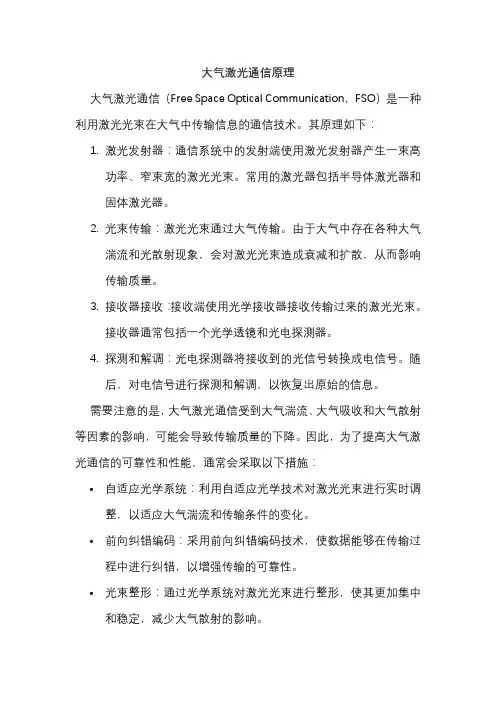
大气激光通信原理
大气激光通信(Free Space Optical Communication,FSO)是一种利用激光光束在大气中传输信息的通信技术。
其原理如下:
1.激光发射器:通信系统中的发射端使用激光发射器产生一束高
功率、窄束宽的激光光束。
常用的激光器包括半导体激光器和
固体激光器。
2.光束传输:激光光束通过大气传输。
由于大气中存在各种大气
湍流和光散射现象,会对激光光束造成衰减和扩散,从而影响
传输质量。
3.接收器接收:接收端使用光学接收器接收传输过来的激光光束。
接收器通常包括一个光学透镜和光电探测器。
4.探测和解调:光电探测器将接收到的光信号转换成电信号。
随
后,对电信号进行探测和解调,以恢复出原始的信息。
需要注意的是,大气激光通信受到大气湍流、大气吸收和大气散射等因素的影响,可能会导致传输质量的下降。
因此,为了提高大气激光通信的可靠性和性能,通常会采取以下措施:
•自适应光学系统:利用自适应光学技术对激光光束进行实时调整,以适应大气湍流和传输条件的变化。
•前向纠错编码:采用前向纠错编码技术,使数据能够在传输过程中进行纠错,以增强传输的可靠性。
•光束整形:通过光学系统对激光光束进行整形,使其更加集中和稳定,减少大气散射的影响。
大气激光通信具有高带宽、免许可、抗干扰等优点,适用于需要高速、远距离、抗干扰的通信场景,例如军事通信、卫星通信、无线回传等领域。
然而,由于大气的不稳定性,大气激光通信在实际应用中仍面临一些挑战,需要通过技术手段进行优化和改进。
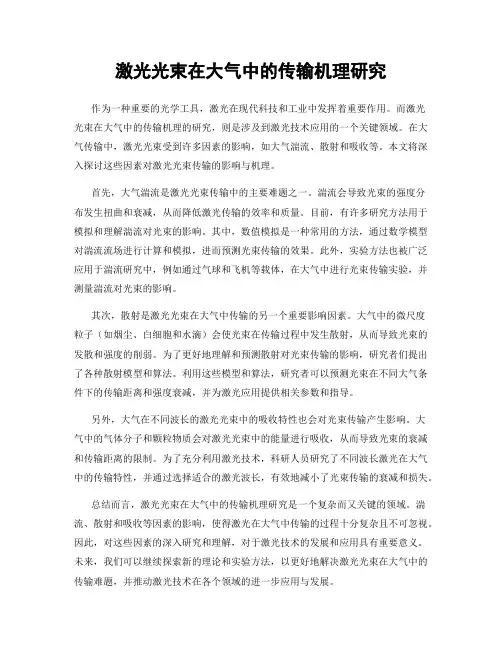
激光光束在大气中的传输机理研究作为一种重要的光学工具,激光在现代科技和工业中发挥着重要作用。
而激光光束在大气中的传输机理的研究,则是涉及到激光技术应用的一个关键领域。
在大气传输中,激光光束受到许多因素的影响,如大气湍流、散射和吸收等。
本文将深入探讨这些因素对激光光束传输的影响与机理。
首先,大气湍流是激光光束传输中的主要难题之一。
湍流会导致光束的强度分布发生扭曲和衰减,从而降低激光传输的效率和质量。
目前,有许多研究方法用于模拟和理解湍流对光束的影响。
其中,数值模拟是一种常用的方法,通过数学模型对湍流流场进行计算和模拟,进而预测光束传输的效果。
此外,实验方法也被广泛应用于湍流研究中,例如通过气球和飞机等载体,在大气中进行光束传输实验,并测量湍流对光束的影响。
其次,散射是激光光束在大气中传输的另一个重要影响因素。
大气中的微尺度粒子(如烟尘、白细胞和水滴)会使光束在传输过程中发生散射,从而导致光束的发散和强度的削弱。
为了更好地理解和预测散射对光束传输的影响,研究者们提出了各种散射模型和算法。
利用这些模型和算法,研究者可以预测光束在不同大气条件下的传输距离和强度衰减,并为激光应用提供相关参数和指导。
另外,大气在不同波长的激光光束中的吸收特性也会对光束传输产生影响。
大气中的气体分子和颗粒物质会对激光光束中的能量进行吸收,从而导致光束的衰减和传输距离的限制。
为了充分利用激光技术,科研人员研究了不同波长激光在大气中的传输特性,并通过选择适合的激光波长,有效地减小了光束传输的衰减和损失。
总结而言,激光光束在大气中的传输机理研究是一个复杂而又关键的领域。
湍流、散射和吸收等因素的影响,使得激光在大气中传输的过程十分复杂且不可忽视。
因此,对这些因素的深入研究和理解,对于激光技术的发展和应用具有重要意义。
未来,我们可以继续探索新的理论和实验方法,以更好地解决激光光束在大气中的传输难题,并推动激光技术在各个领域的进一步应用与发展。
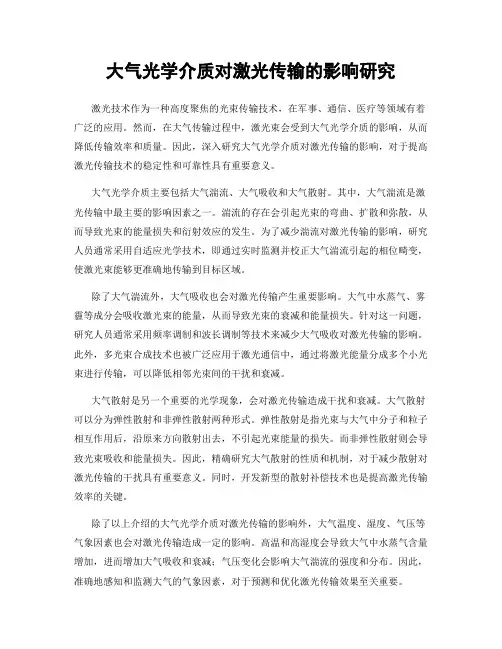
大气光学介质对激光传输的影响研究激光技术作为一种高度聚焦的光束传输技术,在军事、通信、医疗等领域有着广泛的应用。
然而,在大气传输过程中,激光束会受到大气光学介质的影响,从而降低传输效率和质量。
因此,深入研究大气光学介质对激光传输的影响,对于提高激光传输技术的稳定性和可靠性具有重要意义。
大气光学介质主要包括大气湍流、大气吸收和大气散射。
其中,大气湍流是激光传输中最主要的影响因素之一。
湍流的存在会引起光束的弯曲、扩散和弥散,从而导致光束的能量损失和衍射效应的发生。
为了减少湍流对激光传输的影响,研究人员通常采用自适应光学技术,即通过实时监测并校正大气湍流引起的相位畸变,使激光束能够更准确地传输到目标区域。
除了大气湍流外,大气吸收也会对激光传输产生重要影响。
大气中水蒸气、雾霾等成分会吸收激光束的能量,从而导致光束的衰减和能量损失。
针对这一问题,研究人员通常采用频率调制和波长调制等技术来减少大气吸收对激光传输的影响。
此外,多光束合成技术也被广泛应用于激光通信中,通过将激光能量分成多个小光束进行传输,可以降低相邻光束间的干扰和衰减。
大气散射是另一个重要的光学现象,会对激光传输造成干扰和衰减。
大气散射可以分为弹性散射和非弹性散射两种形式。
弹性散射是指光束与大气中分子和粒子相互作用后,沿原来方向散射出去,不引起光束能量的损失。
而非弹性散射则会导致光束吸收和能量损失。
因此,精确研究大气散射的性质和机制,对于减少散射对激光传输的干扰具有重要意义。
同时,开发新型的散射补偿技术也是提高激光传输效率的关键。
除了以上介绍的大气光学介质对激光传输的影响外,大气温度、湿度、气压等气象因素也会对激光传输造成一定的影响。
高温和高湿度会导致大气中水蒸气含量增加,进而增加大气吸收和衰减;气压变化会影响大气湍流的强度和分布。
因此,准确地感知和监测大气的气象因素,对于预测和优化激光传输效果至关重要。
综上所述,大气光学介质对激光传输的影响并不容忽视。
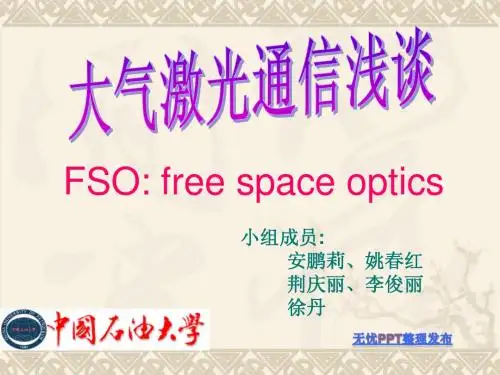
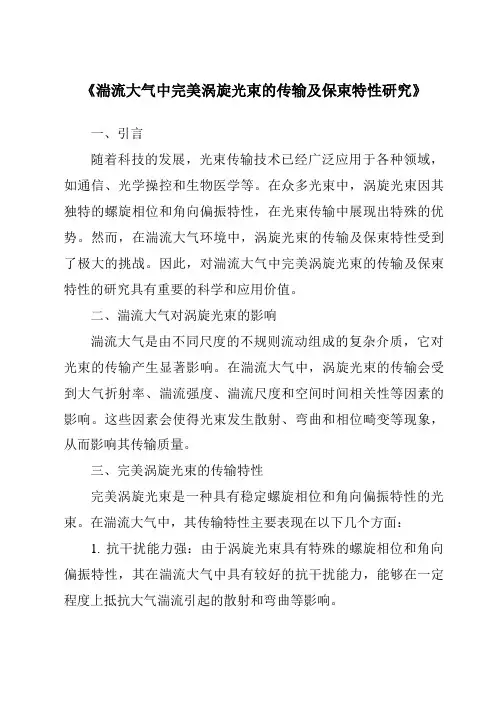
《湍流大气中完美涡旋光束的传输及保束特性研究》一、引言随着科技的发展,光束传输技术已经广泛应用于各种领域,如通信、光学操控和生物医学等。
在众多光束中,涡旋光束因其独特的螺旋相位和角向偏振特性,在光束传输中展现出特殊的优势。
然而,在湍流大气环境中,涡旋光束的传输及保束特性受到了极大的挑战。
因此,对湍流大气中完美涡旋光束的传输及保束特性的研究具有重要的科学和应用价值。
二、湍流大气对涡旋光束的影响湍流大气是由不同尺度的不规则流动组成的复杂介质,它对光束的传输产生显著影响。
在湍流大气中,涡旋光束的传输会受到大气折射率、湍流强度、湍流尺度和空间时间相关性等因素的影响。
这些因素会使得光束发生散射、弯曲和相位畸变等现象,从而影响其传输质量。
三、完美涡旋光束的传输特性完美涡旋光束是一种具有稳定螺旋相位和角向偏振特性的光束。
在湍流大气中,其传输特性主要表现在以下几个方面:1. 抗干扰能力强:由于涡旋光束具有特殊的螺旋相位和角向偏振特性,其在湍流大气中具有较好的抗干扰能力,能够在一定程度上抵抗大气湍流引起的散射和弯曲等影响。
2. 传输稳定性高:完美涡旋光束的传输稳定性较高,即使在湍流大气中,其光束质量也能得到较好的保持。
这主要得益于其特殊的相位和偏振特性,使得其在传输过程中能够更好地抵抗大气湍流的干扰。
3. 传输距离远:由于涡旋光束具有较高的能量密度和较低的发散角,使得其能够在较远的距离上保持较好的传输质量。
在湍流大气中,这一优势更为明显。
四、保束特性的研究为了更好地利用涡旋光束在湍流大气中的优势,对其保束特性的研究显得尤为重要。
目前,针对完美涡旋光束的保束特性研究主要集中于以下几个方面:1. 空间相干性研究:通过研究空间相干性对完美涡旋光束的影响,可以了解其在湍流大气中的传输规律和保束特性。
这有助于优化光束的传输路径和参数设置。
2. 偏振态控制:通过控制涡旋光束的偏振态,可以有效地抵抗湍流大气引起的相位畸变和能量损失。
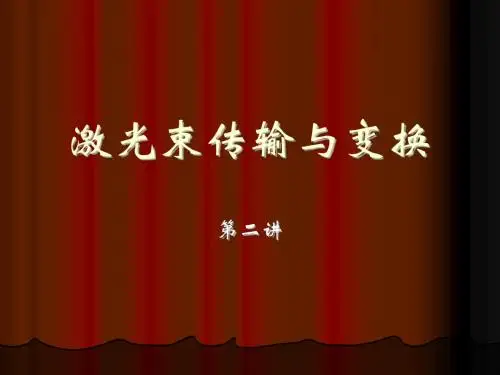

第4章湍流的统计特性及对激光大气传输的影响分析激光大气传输湍流效应本质上就是光在湍流大气中的传播问题。
20世纪50年代前苏联学者Tatarskii引入Kolmogorov和Obukhov发展的湍流统计理论,求解湍流大气中波传播方程,取得的一些理论结果相当好地解释了在此以前所取得的实验结果,从而奠定的光波在湍流大气中传播的理论基础。
然而,由于激光在湍流大气中的传播是一个十分复杂的随即非线性过程,特别是大气湍流存在的间歇性,对激光传输有着难以估计的影响。
4.1大气湍流的成因在大气中,任一点的大气运动速度的方向和大小无时无刻不发生着不规则变化,产生了各个大气分子团相对于大气整体平均运动的不规则运动,这种现象称为大气湍流。
通常情况下大气都处于湍流状态,大气的随机运动产生了大气湍流,由于大气湍流的存在,大气温度和折射率也时刻发生着不规则的变化。
形成大气湍流的原因大致有四点。
第一,太阳的照射造成的大气温度差,太阳辐射对地表不同地区造成加热不同;第二,地球表面对气流拉伸移位导致了风速剪切;第三,地表热辐射产生了热对流;第四,伴随着热量释放的相变过程(沉积、结晶)导致了温度和速度场变化。
图4.1形象的表述了湍流的形成。
上图是英国的物理学家形chardson描绘的湍流的一个级串模型,虽然湍流的运动很复杂,但通过上图仍能对湍流有一个形象的认识。
上图表示湍流含有尺度不同的湍涡,而各种能量从大尺度湍涡一步一步向小尺度湍涡传递。
外界的能量传递给第一级大湍涡,由于受风剪切等因素的影响,大湍涡逐渐变得不稳定形成次级小湍涡,小湍涡再次失稳后再形成更次一级的许多小湍涡。
从图中可以看出,湍涡的大小有限,最大的湍涡的尺寸大小是外尺度L,最小的湍涡是内尺度0l。
尤其重要的是,这些大大小小的湍涡没有分散存在于大气中,而是交叉重叠的存在于大气中。
4.2 Kolmogorov-Oboukhov湍流统计理论虽然迄今为止人们对湍流的基本物理机制尚还不十分清楚,但已形成几个公认的基本概念,包括随机性、涡粘性、级串、和标度率。